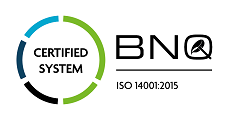
Standard ISO 14001
Environmental Management Systems - Requirements and Guidelines for Use
The ISO 14001 standard is internationally recognized and intended for organizations wishing to implement, maintain and improve an environmental management system. The standard sets out requirements for such a system and deals more specifically with environmental aspects deemed controllable by the organization. It also deals with environmental aspects that the organization may influence to a certain degree. In short, the ISO 14001 standard is a reference framework that organizations may use to set up an effective environmental management system that assures staff, stakeholders and management that the organization’s environmental impacts are subject to serious actions and meaningful improvements.
-
Download standard
This standard is available on the ISO website.
Certification Offer
 Organizations wishing to have their environmental management system recognized may contact the BNQ, whose ISO 14001 system certification program is accredited by the Standards Council of Canada (SCC). To obtain certification, organizations must demonstrate to the BNQ that they meet the requirements of the ISO 14001 standard.
Organizations wishing to have their environmental management system recognized may contact the BNQ, whose ISO 14001 system certification program is accredited by the Standards Council of Canada (SCC). To obtain certification, organizations must demonstrate to the BNQ that they meet the requirements of the ISO 14001 standard.
These requirements involve the following:
- planning (environmental aspects, objectives, targets, programs, legal requirements and other requirements)
- implementation and operation (for example, resources, roles, accountability and authority, communications, documentation)
- control (for example, monitoring and measurement, compliance assessment, internal audit);
- management review.
You can benefit by certifying your environmental management system through the BNQ, for example by gaining access to new markets, increasing your return on investment by optimizing the use of resources while improving the environmental performance of your business, or by reassuring your investors. This certification program is accredited by the Standards Council of Canada.
-
Certification steps
The BNQ’s process for certifying environmental management systems (EMSs) meets the latest applicable national and international accreditation requirements.
A certification cycle normally spans a three-year period during which maintenance audits must be conducted at 12-month intervals.
The process begins with an initial application for certification submitted using the accessible form under the previous heading, which must be emailed toThis email address is being protected from spambots. You need JavaScript enabled to view it. . Once a service contract between the BNQ and the client has been signed and the client’s EMS documentation has been sent to the BNQ, the name of the proposed auditor is given to the client.
Before the certification desk audit, a preliminary assessment of the client’s preparedness level is made, in particular by reviewing the documentation sent by the client. The results of this preliminary assessment are communicated to the client in a written report that makes an initial finding on the system’s compliance with the documentation requirements of the standard and on the client’s level of understanding and implementation of the requirements of the standard. If the findings are favourable, the auditor in charge prepares an audit plan and sends it to the client.
The certification audit then takes place, and the auditor collects relevant information pertaining to the requirements of the standard, and then verifies it. The information is collected by conducting interviews, observing activities and the work environment, and reviewing documents on site. The client is informed about the auditor’s findings as the audit progresses, and the findings are also included in the written report summarizing the auditor’s conclusions.
Discrepancies found during the audit may be the subject of minor or major corrective action requests (CARs), depending on the materiality of the discrepancy in terms of achieving the objectives of the standard. CARs should normally be closed within 30 days of the audit.
The decision on whether or not to certify the EMS is based on the recommendation of the auditor in charge combined with a review of the file by the BNQ, to ensure that all the certification conditions have been fulfilled.
If the decision is favourable, a certificate is sent to the client, which must then agree to undergo an initial maintenance audit within 12 months of the first day of the initial certification audit. - Download document required for certification
-
Why choose the BNQ?
- For our accreditation through the Standards Council of Canada (SCC), which give us credible international recognition
- For our transparent and impartial approach
- For our desire to contribute to Quebec’s economic development
- For our expertise and achievements in a range of fields
Certifying your EMS will enable you to
- Demonstrate your best management practices
- Instill confidence in your clients, suppliers, shareholders and other partners
- Strengthen your position in markets
Specifically, by choosing to certify your EMS through the BNQ, you can obtain numerous benefits, such as gaining access to new markets, increasing the return on investment by optimizing the use of your resources while improving your business’s environmental performance, and reassuring your investors.
-
Request an estimate
- Fact sheets
-
Contact
Nancie Carrière
Sales Technician
Bureau de normalisation du Québec
Cell.: 581-998-3625This email address is being protected from spambots. You need JavaScript enabled to view it.









